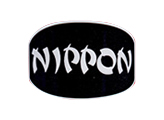Caring for topiary
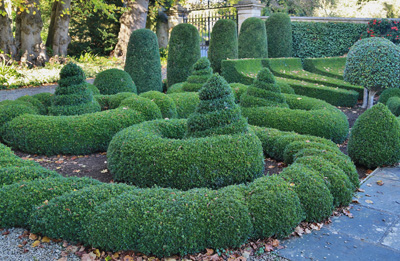
The art of topiary: trimming and training a shrub to maintain it as a controlled shape, dates back to the Romans and remains enduringly popular. Common box, bay and yew are the most familiar subjects traditionally used for topiary, but today the range of evergreens used for topiary is much wider. Some of these subjects are faster growing, therefore less expensive to buy. Others offer a greater variety of colour, texture and plant shape. Most make excellent subjects for pots and containers and their controlled size makes them ideal for small gardens. All you have to do it trim them regularly to keep them in shape, and remember to feed and water them. Although they are not designed to grow in size, they need to thrive and remain healthy.
Growing topiary in containers
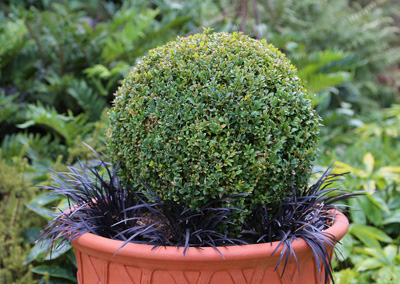 Simple topiary shapes look stylish in containers, both in traditional and contemporary settings. They are ideal for patio and doorstep; often positioned in pairs to mark an entrance. Used in this way their careful shaping and condition is all the more important to maintain identical appearance.
Simple topiary shapes look stylish in containers, both in traditional and contemporary settings. They are ideal for patio and doorstep; often positioned in pairs to mark an entrance. Used in this way their careful shaping and condition is all the more important to maintain identical appearance.
Common box, Buxus sempervirens and bay are easy to maintain. They are drought tolerant and good long-term pot subjects. Yew, Taxus baccata, is not. It dislikes pot cultivation and is much happier in the open ground. Other good subjects for topiary in pots include Japanese holly (Ilex crenata), Euonymus japonicus ‘Microphyllus’, Common holly (Ilex aquifolium), Photinia x fraseri andPortugal laurel (Prunus lusitanica) to name but a few.
To grow any topiary subject in a pot the secret of success is to use a good sized pot that holds plenty of growing medium. A loam based growing medium: John Innes No. 3 is the best choice, because it effectively holds on to moisture and nutrients for the plant to use. It does not dry out as quickly as soil-less composts and keeps a plant happy for years with just annual feeding.
Keeping topiary in shape
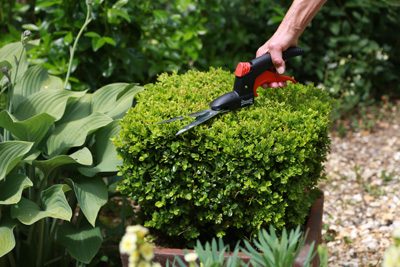 All topiary subjects need regular trimming. As a general rule mid-summer is the right time to do this: after the flush of spring growth has happened and well after any late frosts. This is particularly important with common box. Early trimming results in a flush of soft new growth which is then susceptible to frost damage.
All topiary subjects need regular trimming. As a general rule mid-summer is the right time to do this: after the flush of spring growth has happened and well after any late frosts. This is particularly important with common box. Early trimming results in a flush of soft new growth which is then susceptible to frost damage.
Topiary shears are one handed shears; they take some getting used to but they do give control, and avoid cutting flat facets on a sphere: a danger with long-bladed shears. If you cannot cut through the foliage and stems with topiary shears then you have left it too long to trim.
Alternatively use short-bladed, sharp, hedge shears and trim lightly, you can always go over the plant more than once to achieve the perfect shape. With larger-leaved subjects such as bay, using secateurs to snip back individual shoots avoids the cut leaves that result from the use of shears.
Watering and feeding
Of course anything growing in a pot needs regular watering. Checking the pot regularly to make sure it does not dry out is important, even in winter when the weather is mild. Pots close to the walls of the house are particularly susceptible and a dry plant is susceptible to leaf drop.
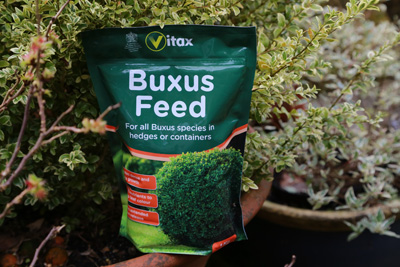
Regular watering washes nutrients from the compost and these need to be replenished. If they are not the plants become starved and their health suffers, making them more susceptible to discolouration and disease. An application of Vitax Buxus Feed in spring and again in mid-summer, after trimming supplies all the nutrients any topiary subject needs. Although specifically formulated for box, it is ideal for all evergreen topiary.
Topiary in the open ground
The treatment of topiary in the open ground is exactly the same when it comes to trimming and shaping. Vitax Buxus Feed is the ideal fertiliser, applied twice a year in the same way that you would use it for pots and containers. Topiary evergreens have dense, fibrous root systems and the ground around them can become starved and dry, therefore feeding and watering in dry weather is just as important to keep them healthy and attractive.
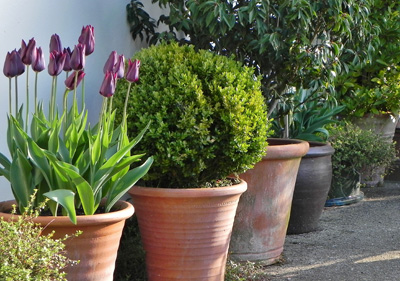
Yew, Taxus baccata, is ideal for larger topiary in the open ground. Trim it in mid-summer.
Andy McIndoe for Vitax
Your login details have been used by another user or machine. Login details can only be used once at any one time so you have therefore automatically been logged out. Please contact your sites administrator if you believe this other user or machine has unauthorised access.







